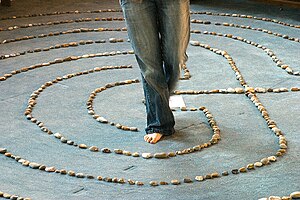The labyrinth holds an ancient meaning as a prompt for prayer.
The winding path leads to the center; this serves as a mirror to reflect the movement of the Spirit in our lives.
It is a path of symbolism leading from earth to God.
There are no tricks, no dead ends. It is a walk with a heart and mind open to Christ, open to the spiritual journey of our lives.
The winding path leads to the center; this serves as a mirror to reflect the movement of the Spirit in our lives.
It is a path of symbolism leading from earth to God.
There are no tricks, no dead ends. It is a walk with a heart and mind open to Christ, open to the spiritual journey of our lives.

Early Christian labyrinths date back to a basilica in Algeria during the 4th century. The most famous is the Chartres Cathedral Labyrinth, France (1220 AD). They were used to symbolically represent the pilgrimage to the Holy Land during the Middle Ages. A more recent example can be found at Grace Cathedral in San Francisco.
The basic shape of the labyrinth is Cruciform. This significant Christian symbol of the cross is readily visible in the four arms of the design.
The four corners around the cross represent the four gospels of Matthew, Mark, Luke, and John; as well as the four seasons and stages of the life.To create eleven paths or circuits requires twelve circles for the twelve tribes of Israel and the twelve disciples, serving as a reminder of our communal need to care for one another.
The labyrinth journey has three phases.
Purgation
Letting go – the path inward.
IlluminationClarity, insight, and openness to receive – the journey center.
UnionIntegration of what is learned from the prayer experience into action in the world – the path outward.The labyrinth represents the path of grace of our sacred Christian journey. Historically it has been used as a pilgrimage for soul searching. Today, labyrinths are being used for meditation, reflection, problem solving, comfort and prayer.People have different experiences walking the labyrinth. As with all practices of prayer or meditation, the experience will grow and deepen the more it is done.
I have never walked a Labyrinth before but I have to say the notion intrigues me. I practice contemplative prayer and have experienced how entering into God's presence during the present moment can be amazingly transforming. I like the concept of labyrinths. Not only the symbolism and great care and thought in their construction, but the idea of opening my heart to God, each step being a prayer in motion, lifted up towards our Creator.

Something beautiful happens when we surrender our hearts and time to God. When we rid ourselves of our false egos and instead find our identity in Christ, having him seated on our heart's throne filling us with his love and compassion. With expectation I enter those times, knowing God delivers unto my soul beautiful moments gilded with grace where my heart, though often hard and callous opens up, is penetrated by His light and healing warmth and is flooded with insights, truths, peace and a sense of His mercy. It is then that I often sit still in wondrous awe of the glory of God. What an amazing God we have.
So...labyrinths intrigue me. I look forward to walking at some point. From all accounts they seem to be a profound experience for prayer as well as meditation.
So my question to you is: Have you ever walked a labyrinth? If you have please share your experience! If you haven't...would you consider walking one? Why or why not?